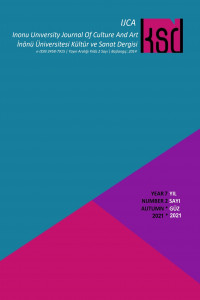Abstract
Son yıllarda tartışmaya açık ifadelerle değerlendirilen günümüz müziği; etkilendiği akımlar, kullanılan teknikler ve belirlenmiş dönemlerde yer alan bestecilerin yeniyi arama çabaları ile alan çalışmalarında fazlaca yer almaya başlamıştır. Bununla birlikte bestecilerin herhangi bir dönem içerisinde değerlendirilmesi aslında birçok bestecinin kabul etmediği bir olgu olarak bilinmektedir. Besteciler orta çağdan günümüze birçok teori ve sistem geliştirmiş, uygulamış ve bu uygulamalar ile dönemler açılıp kapanmıştır. Ancak bu gelişmeler hiçbir zaman bestecilerin dönem kapatmak amacıyla gerçekleştirdiği bir yenilik olarak değerlendirilmemiştir. Besteciler her dönemde yeniyi ve farklıyı aramış ve geliştirdiği sistemler topluluklar tarafından kabul edilmiş ve uygulanmıştır. Bu durum dolayısıyla akımlar , dönemler vb. terimlerin oluşumuna neden olmuştur. Her akımın veya her dönemin bir öncekinin eleştirisi veya geliştirilmesi ile oluştuğu görüşüyle; müzik dönemleri içerisinde de işte bu gelişmelerin en önemlilerinden olan “On İki Ton Sistemi” çalışmada detaylı bir şekilde aktarılmıştır. Geliştirilen bu sistem büyük tepkiler aldığı gibi büyük topluluklar tarafından da kabul edilmiştir. Bu tartışmalar eşliğinde kabul gören bu sistemin daha iyi tanınması amacıyla, çalışmada Josef Matthias Hauer’in oluşturduğu, Arnold Schoenberg’in geliştirdiği, Anton Webern’in günümüze ulaştırdığı on iki ton sistemi örnekler ile açıklanmıştır. Aynı zamanda Anton Webern’in ilk denemelerinden olan “Klavierstück, im Tempo eines Menuetts (1925)” eseri üzerinde incelemeler yaparak sisteme ve analiz yöntemine bir bakış açısı sağlanmıştır.
Keywords
References
- Bailey, K. (2006). The twelve-note music of Anton Webern: Old forms in a new language (No. 2). Cambridge University Press.
- Ballance, J. (2021, July). The Path to the New Note: Interval Distributions in the Music of Anton Webern. In 8th International Conference on Digital Libraries for Musicology (pp. 59-66).
- Beach, D. W. (1976). Segmental Invariance and the Twelve-Tone System. Journal of Music Theory, 20(2), 157-184.
- Gedikli, N. (1999) Ülkemizdeki Etki ve Sonuçlarıyla Uluslararası Sanat Müziği, Ege Üniversitesi Basımevi, İzmir,
- Kalkan, Ş. (2006) Dizinsel Müziğe Giden Yol, Dokuz Eylül Üniversitesi Güzel Sanatlar Enstitüsü, Yüksek Lisans Tezi, İzmir
- Kolneder, W. (1974). Anton Webern: Genesis u. Metamorphose eines Stils (Vol. 19). Wien: Lafite: Österr. Bundesverl..
- Kutluk, F. (1997). Müziğin Tarihsel Evrimi. Çiviyazıları, İstanbul, 93.
- Mead, A. (1992). The Twelve-Note Music of Anton Webern: Old Forms in a New Language.
- Moldenhauer, H. (2021) “Anton Webern”, Encyclopaedia Britannica Inc. https:// www.britannica.com /biography/Anton-Webern Needley, D. (1974). A study of parametric organization in selected works of Luigi Nono (Doctoral dissertation, University of British Columbia).
- Özçelik, S. (2001). On İki Ton Besteleme Tekniği. Gazi Üniversitesi Gazi Eğitim Fakültesi Dergisi, 21(3).
- Samuels, R. (2019) Schoenberg’s Coalition Chess, Chessandmusicworldpress. “https://chessandmusic.wordpress.com/2019/03/05/schoenbergs-coalition-chess/”
- Webern, A. (1998) Yeni Müziğe Doğru Çev. Ali Bucak, Pan Yayınları
- Yöre, S. (2012). Temel besteleme malzemeleriyle çağdaş müzik. İstanbul: Bağlam.
Abstract
Contemporary music, which has been evaluated with controversial expressions in recent years, has begun to take part in field studies with the movements, techniques used and the efforts of composers in certain periods to search for the new. However, the evaluation of composers in any period is actually known as a phenomenon that many composers do not accept. Composers have developed and applied many theories and systems from the middle ages to the present, and periods have been opened and closed with these applications. However, these developments were never considered as an innovation by composers to close the period. Composers sought the new and different in every period, and the systems they developed were accepted and implemented by the communities, which therefore gave rise to the terms such as flows, periods, etc... With the view that each movement or each period is formed by the criticism or development of the previous one; “Twelve Tone System”, which is one of the most important of these developments in music periods, is explained in detail in the study. Not only has this developed system received great reactions but it has also been accepted by large communities. In order to better recognize this accepted system in the light of these discussions, the twelve tone system created by Josef Matthias Hauer, developed by Arnold Schoenberg and brought to the present day by Anton Webern is explained with examples. At the same time, a perspective on the system and analysis method is provided by examining one of Anton Webern's first essays, "Klavierstück, im Tempo eines Menuetts (1925)".
Keywords
References
- Bailey, K. (2006). The twelve-note music of Anton Webern: Old forms in a new language (No. 2). Cambridge University Press.
- Ballance, J. (2021, July). The Path to the New Note: Interval Distributions in the Music of Anton Webern. In 8th International Conference on Digital Libraries for Musicology (pp. 59-66).
- Beach, D. W. (1976). Segmental Invariance and the Twelve-Tone System. Journal of Music Theory, 20(2), 157-184.
- Gedikli, N. (1999) Ülkemizdeki Etki ve Sonuçlarıyla Uluslararası Sanat Müziği, Ege Üniversitesi Basımevi, İzmir,
- Kalkan, Ş. (2006) Dizinsel Müziğe Giden Yol, Dokuz Eylül Üniversitesi Güzel Sanatlar Enstitüsü, Yüksek Lisans Tezi, İzmir
- Kolneder, W. (1974). Anton Webern: Genesis u. Metamorphose eines Stils (Vol. 19). Wien: Lafite: Österr. Bundesverl..
- Kutluk, F. (1997). Müziğin Tarihsel Evrimi. Çiviyazıları, İstanbul, 93.
- Mead, A. (1992). The Twelve-Note Music of Anton Webern: Old Forms in a New Language.
- Moldenhauer, H. (2021) “Anton Webern”, Encyclopaedia Britannica Inc. https:// www.britannica.com /biography/Anton-Webern Needley, D. (1974). A study of parametric organization in selected works of Luigi Nono (Doctoral dissertation, University of British Columbia).
- Özçelik, S. (2001). On İki Ton Besteleme Tekniği. Gazi Üniversitesi Gazi Eğitim Fakültesi Dergisi, 21(3).
- Samuels, R. (2019) Schoenberg’s Coalition Chess, Chessandmusicworldpress. “https://chessandmusic.wordpress.com/2019/03/05/schoenbergs-coalition-chess/”
- Webern, A. (1998) Yeni Müziğe Doğru Çev. Ali Bucak, Pan Yayınları
- Yöre, S. (2012). Temel besteleme malzemeleriyle çağdaş müzik. İstanbul: Bağlam.
Details
| Primary Language | Turkish |
|---|---|
| Journal Section | Araştırma Makalesi |
| Authors | |
| Early Pub Date | December 29, 2021 |
| Publication Date | December 29, 2021 |
| Published in Issue | Year 2021 Volume: 7 Issue: 2 |

